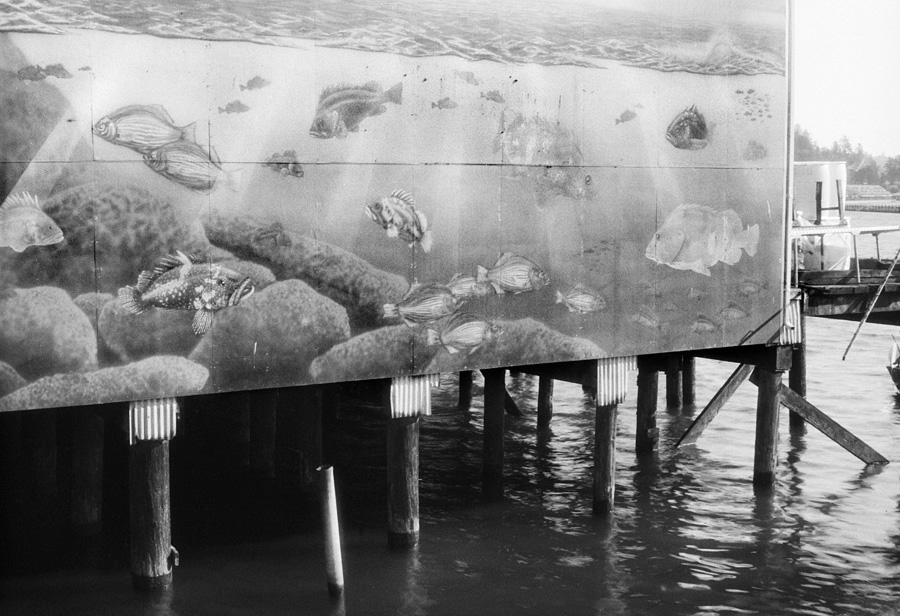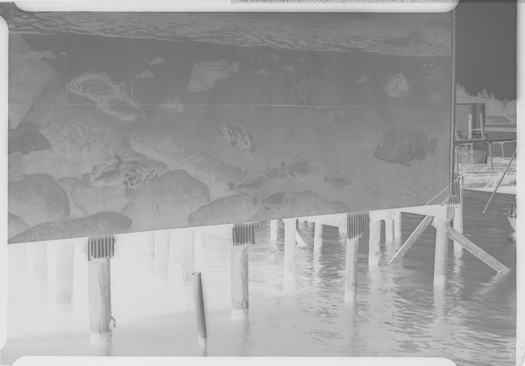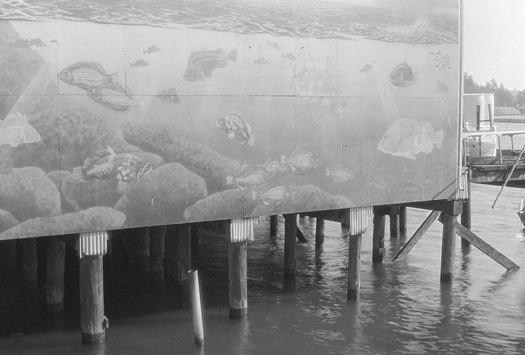"TLF-X2Ag" — Speedy Stuff. Nice!
February 10, 2012
Winter Sun, Newport, Oregon
Except for making me realize that Photoshop really is the Devil's Workshop (as in, "idle hands are...") I think this emulsion is a keeper. The print above was shot at f/11 and ¼ second and developed in a moderate strength formulation. The print procedure went scan, invert, crop, auto levels, burn tool on the mural, and USM 15/35/1. Beyond that I had to do a little spotting in the water area, almost all from dust picked up in the scanner. I resisted the temptation to play with all the files. No one who mucks about in Photoshop can legitimately complain about the time involved with chemical photography!
I'm finally managing to avoid almost all scratches on my negatives. It turned out I just had to put a piece of YUPO (plastic paper) on the bed of my rotary cutter. I still can't feel any rough areas on the metal surface, but the film sure can. Also, I've identified a couple of film holders that have rough septum surfaces. I'm only using those for testing with selvage pieces. The subbing is annoyingly tender. Small price to pay, though, for the convenience and otherwise quality.
Below are four takes on the scene—the negative and its "crop/invert/auto levels." The shadows under the dock on this day were Stygian. While I was setting up, a seagull swimming on the water floated into the gloom and essentially disappeared. The mural, on the other hand, was directly sunlit. The goal was obviously "exposing for the shadows—developing for the highlights" but it's plain that development also affects shadow detail. And, although it's a little hard to see on the screen, development seems to affect irradiation, regardless of exposure.

This was my baseline exposure and development: f/11 at ½ second in "Defender 55Dwr" stock for 5 minutes with agitation at half-minute intervals, followed by hardening stop and non-hardening fix.


This negative was exposed for 1 second at f/11, followed by a severe pull-back on development: 2 minutes in Defender 55Dwr stock. Three minutes would probably have made it a close match with the ½ negative. As it is, I didn't pick up the shadow detail I had hoped from a full second exposure.


This is the negative for the title print: f/11, ¼ second, in Defender 55Dwr 1:1 with a splash of 2% BZT, for 5 minutes. It's fun to see water with definition after all the super-slow exposure water blurring I've gotten used to. The exposure was fast enough that a seagull "ghost" ended up in the image (in the background tree line). At slower exposures, flying birds pretty much disappear. If I had been interested only in the brightly lit areas of the scene, I could have shot this at ⅛ second or faster, and pushed the development a little. At a larger aperture, this emulsion should approach hand-held speeds during summer.


A contrast-contraction success story: This negative was exposed identically to the first one (f/11 and ½ second) but developed in D23 1:2, for 10 minutes.


Of course, all things are never equal. There is an inherent balancing act with exposure/development/developer formulation. The ¼ second negative in Def, 1:1, has softer grain than the ½ second negative in D23, 1:2.

The take-home message here for me is that it's high time to get serious about exposure/developer testing with regard to the best characteristics for "scan-to-screen image," "scan-to-enlarged inkjet negative for contact printing," "negative for enlarger printing," and "in-camera LF negative for contact printing." What's perfect for one application is by no means assured to be perfect for another.
Also, although I predicted perfectly (this time) the right exposure for TLF-X2Ag as a colorblind film, I missed wildly with it shot as ortho. It does not react the same as TLF#2-Ortho. From studying the literature, I think I'm figuring out why, but more testing is needed. Right now, I'm off to the darkroom to cut up a second batch of this stuff. I don't know yet if I've got an emulsion that can be reliably duplicated, or if it was just one time dumb luck. "Pray for the emulsion" (George Eastman). +1.
Fingers crossed...
Update: Looks great! And I've got 70 sheets loaded and ready to go. (Ten hours of standing work over three days, but less than $10 in materials—admittedly, an upside down metric from modern photography.)
